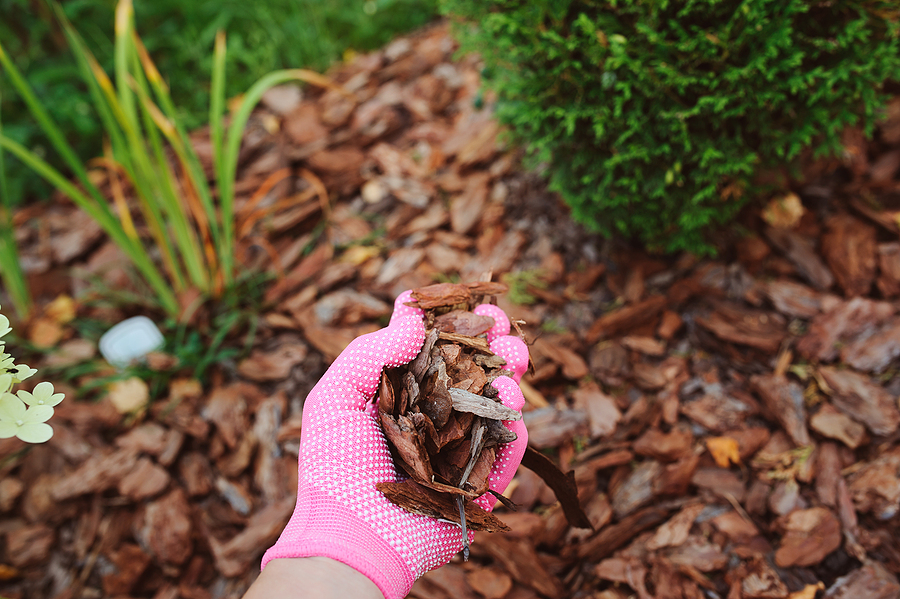Should you be using woodchip in your garden – and what are its benefits?
Experts offer their take on this popular mulch.
At a time when climate change is very much in the spotlight, gardeners are becoming more aware of how they can enhance soil, grow plants organically and generally help the environment. So, where does woodchip play a part in all that?
“The most understood way to use it is as a mulch,” says Ben Raskin, head of horticulture at the Soil Association. “Historically people have used it on paths or under trees. It’s a good way of keeping weeds down, of holding in moisture, and typically reduces irrigating needs by about 25%.
“But as well as those properties, there is a lot more potential.”
It’s LAUNCH DAY for the Woodchip Handbook – you can now get your hands on a shiny new copy. From @chelseagreen or DM if you’d like to buy direct for a signed copy.https://t.co/oToik3hbC2 pic.twitter.com/RsptMuLbI8
— Ben Raskin (@Ben_Raskin) November 4, 2021
Raskin has now written The Woodchip Handbook, explaining the many uses of woodchip as a renewable, eco-friendly resource for the garden and also something that can be used year-round.
He shows it has tremendous potential to enhance soil health and plant growth and is often readily available either through local arborists or by cutting back and trimming your own trees.
It enriches the soil
Interesting insights from trial evaluating the use of woodchip compost as a viable #peat-free growing media for #growers. The trial showed that #woodchip #compost can provide a good alternative to commercially available, peat-based growing media https://t.co/QBlf7KZ9pV @IFarmers pic.twitter.com/ngtHhARR7N
— Agricology (@agricology) August 5, 2020
“As you are adding organic matter to the soil you are building soil health, so by adding a woodchip mulch you are gradually improving the health of your soil.
“Wood takes quite a long time to break down and has a complex structure called lignin. If you put a green waste compost or your own homemade compost on the soil it will break down quickly, whereas if you put woodchip down it takes longer to break down, so it effectively gives you a longer lasting organic carbon content to the soil.”
He says that if it rains, the woodchip nutrients won’t be leeched out. Woodchip will also hold on to loose nutrients – some farmers add manure to woodchip to get a slow release of nutrients.
It’s fungi-friendly
Amazing #fungi suddenly appeared in our #woodchip #mulch around our #organic fruit trees pic.twitter.com/nUcHbEY13l
— Manor Organic Farm (@manororganic) October 9, 2021
“Woodchip favours fungi. Typically our soils don’t have enough fungi in them. When you see a mushroom on top of the soil, that’s just the fruiting body. The mycelium (roots of the mushroom) spread out underneath the soil. Woodchip builds soil fungi and feeds other soil organisms.
“When you have that network of roots under the ground, they transport nutrients around. Plants tap into that network. Often shrubs and trees will grow better if there are mushrooms nearby. They love a much richer fungal diversity in the soil.”
And helps sequester carbon…
“Mushrooms are really good at sequestering carbon. With trees, you are sequestering carbon in the trunk of the tree and the leaves, but a good fungal network will also sequester carbon, so you get more bang for your buck.”
It can deter pests
Woodchip from strong smelling trees, such as eucalyptus, can deter winter moth larvae, which live in the soil under fruit trees and chomp through the leaves of deciduous trees and shrubs.
But don’t dig it in…

“If it’s fresh you definitely don’t want to dig it in. People get nervous of nitrogen robbing. Because the woodchip needs some nitrogen to break down, it sucks nitrogen from around it and in extreme circumstances, that can mean the plant you are mulching will be nitrogen deficient.
“But I have found the risk is much less than people are worried about.”
Is woodchip ethical?

“It depends on where you source the woodchip, but in theory a lot of woodchip is produced by tree surgeons cutting down trees that need to be cut down, whether they are diseased or overgrowing,” he notes.
Guy Barter, RHS chief horticulturist, adds: “Woodchips make good mulch that improve soil, conserve soil moisture and aid biodiversity, supporting many fungi, insects and other invertebrates.
“Gardeners, including the RHS, largely use chipped wood from local tree surgeons which is highly sustainable.
“Commercial woodchip sources include wastes from forestry activities. Forestry in developed countries involves managed woodlands, replanted after harvesting timber, and in principle is sustainable.
“The RHS encourages gardeners to recycle woody wastes from their garden perhaps by using a shredder to make woodchips in situ.”
How can you make your own woodchip?
Hire a woodchipper if you have a small garden. Typically a shredder will do the job of breaking down prunings and smaller garden materials, Raskin advises.
Finally finished, the end result is a beautiful fine shredded mulch, much better than coarse chips! #circulargardening #gardenshredder pic.twitter.com/sA50O56JRz
— Mark Laurence (@MLaurenceDesign) April 13, 2020
Alternatively, you can buy bigger bags from online retailers or a website called Arbtalk run by tree surgeons, which has a directory.
A lot of tree surgeons have to pay to dump their woodchip, so if you have somewhere they can drop a little truckload off, you may get some for free.
Does size of woodchip matter?

Woodchip which has been broken down after a year
“If you want it as a mulch around trees, you want quite big bits of hard wood, which will give you the best weed control. If you are using it to mulch a ‘no dig’ vegetable bed, you want it well rotted and smaller because otherwise it will affect the growth of plants.”
Smaller chip size is more effective at holding moisture but will break down quicker, while older chips that are already partly broken down will not last as long as fresher material, he notes.
The Woodchip Handbook by Ben Raskin is available now.
The Press Association
Latest posts by The Press Association (see all)
- Beatles documentary Let It Be to be released on Disney+ - April 16, 2024
- How to keep your money safe – as criminals ramp up AI tactics to steal consumer data - April 16, 2024
- Seasoned marathon runners give their best race day tips for first-timers - April 16, 2024
- What are heat pumps and could they help your home save energy? - April 15, 2024
- Trailer for Bridgerton season three teases new friends-to-lovers romance - April 12, 2024





















